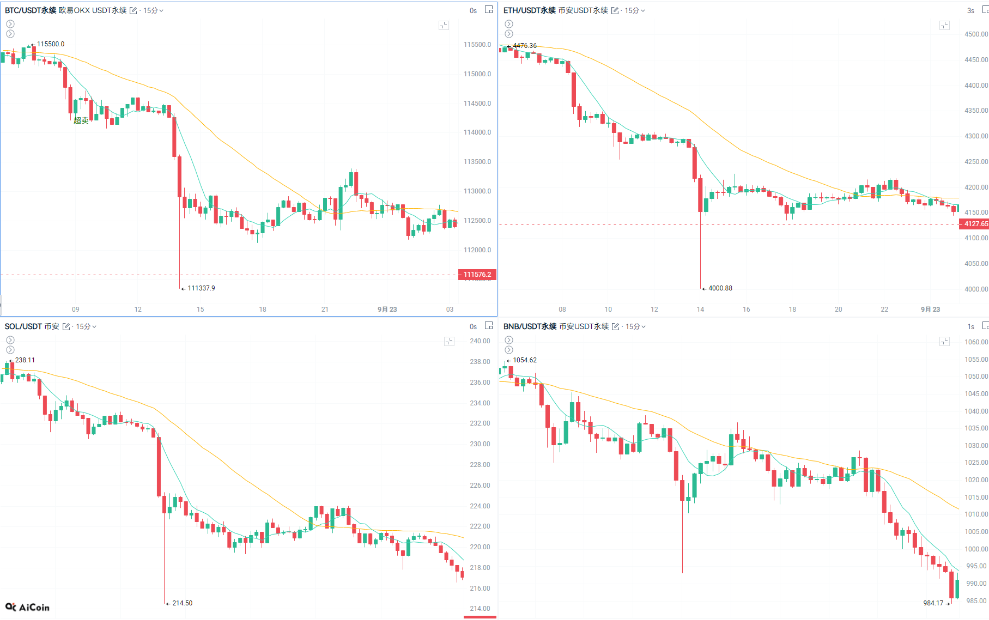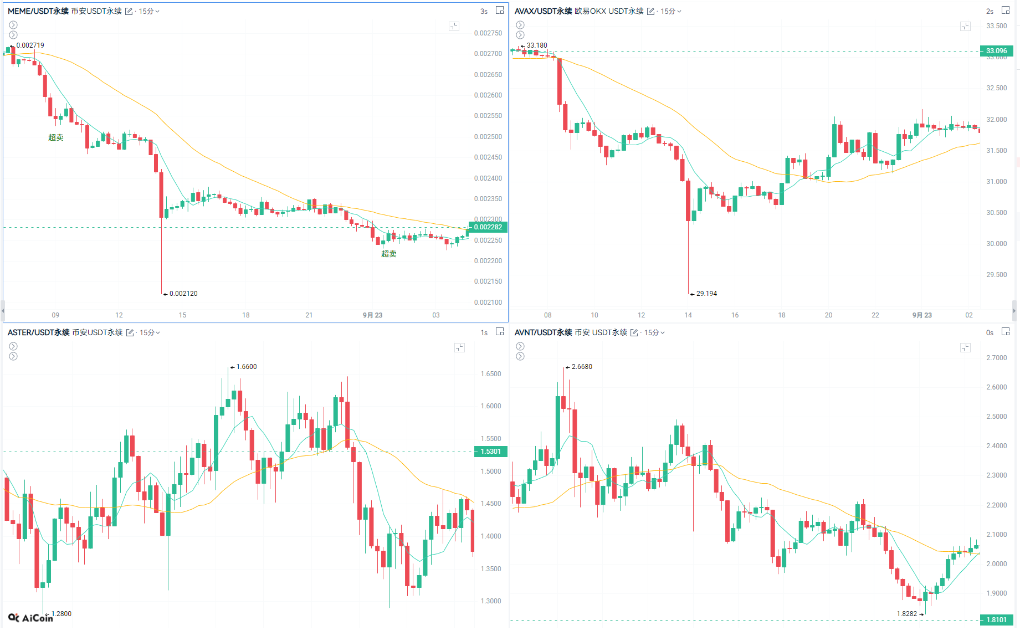Trigger Description: On September 22, 2025, the cryptocurrency market experienced severe fluctuations, with Bitcoin's price dropping below $112,700 and Ethereum plunging 6.7%, leading to a total market capitalization shrinkage to $3.87 trillion and a fear index dropping to 45. The core trigger of this event shifted to the uncertainty surrounding the U.S. H-1B visa reform policy, raising concerns about talent and capital outflow, compounded by the amplifying effects of high-leverage trading. This significant volatility stemmed more from the market's inherent instability and the manifestation of asset bubbles.

I. Market Turmoil: $1.7 Billion Liquidation Triggers Chain Reaction
In the past 24 hours, the global cryptocurrency market has faced intense turbulence, with Bitcoin (BTC) price falling below the critical support level of $112,000 and Ethereum (ETH) also losing the $4,200 mark, resulting in heavy losses for long contract investors. Statistics show that this volatility caused over $1.7 billion in long and short contract liquidations, affecting major exchanges worldwide. The high leverage trading ratio and structural issues of insufficient liquidity in the market have been laid bare in this round of decline, becoming key factors exacerbating the volatility.

The triggers for this decline are complex and varied, covering multiple sub-sectors. The Meme sector overall plummeted by 5.93%, with core projects like Pump.fun and BUILDon seeing declines of over 10%; recently hot coin ASTER saw a slight price drop of 3.11% within 24 hours, while AVNT's price significantly fell by 12.5%; decentralized finance (DeFi), Layer 1, and centralized finance (CeFi) sectors also did not escape, indicating that even investors with relatively diversified asset allocations found it difficult to avoid market risks. Analysts point out that profit-taking and concentrated liquidation behavior triggered by large holders may create a chain reaction, breaking the market's fragile balance.

II. CEX High-Leverage Risks and Intensified Market Turbulence
● High-Leverage Trading Amplifies Market Vulnerability
The design flaws in centralized exchange (CEX) mechanisms are particularly prominent during cryptocurrency market fluctuations, with high-leverage trading being a significant factor causing market turmoil. In the recent volatile market, some platforms offered extremely high leverage ratios, allowing investors to leverage large investments with minimal funds, which significantly increased the risk of account liquidations during sharp price changes. A slight decline in asset prices could trigger large-scale forced liquidations, further causing price slippage and creating a spiral "liquidation effect": starting from a few account liquidations, it expands into a larger liquidity crisis, ultimately multiplying market pressure.
● Lagging Risk Control Mechanisms Intensify Losses
Some CEXs' dynamic risk control mechanisms have failed to keep pace with the rapid fluctuations in asset prices. This is reflected in many platforms' inability to timely adjust margin requirements or limit leverage ratios. Some exchanges even continued to allow users to trade with leverage of 70x or even 100x in highly unstable conditions, while severe valuation fluctuations turned this strategy into a significant risk. Once these high-leverage accounts are liquidated, it not only leads to individual investors' capital losses but also negatively impacts the overall market depth and stability.
● Transparency Issues Heighten Distrust
Due to the nature of centralized management models, ordinary investors cannot directly access transparent information about leverage data, liquidation processes, and risk control strategies within exchanges. For example, some CEXs have not disclosed how they calculate maintenance margins or automatic liquidation thresholds, raising doubts among many investors about the fairness of trading. Worse still, during operational failures like the recent Crypto.com data leak, this lack of disclosure not only undermined investor confidence but also prompted more people to scrutinize the long-term impact of high-leverage trading on market health.
III. Correction or Crisis? The Game of Market Sentiment and Capital Flow
In the face of severe market conditions, institutional and retail investors have reacted differently. Retail investors tend to quickly cut losses to limit damage, while institutional investors seize the opportunity to accumulate at lower prices. External market signals indicate that Goldman Sachs has raised its S&P 500 target to 7,200 points, with U.S. stocks steadily rising, potentially providing support for a subsequent rebound in crypto assets. However, some token prices have already fallen back to early-year lows, and market sentiment continues to deteriorate, with expectations of interest rate cuts exacerbating the trend of capital flowing into traditional financial assets, putting pressure on the crypto market.
Notably, some innovative projects have demonstrated strong resilience against declines. For instance, AVAX and OG have risen against the market downturn, highlighting their unique value. Meanwhile, the market is exploring diversified investment tools to mitigate risks, such as Kraken's Bundles, which bundle BTC and ETH with fixed weights to reduce the impact of single-coin volatility.
IV. Reflection and Path Forward: CEX Reform and New Paths for Diversified Investment
The recent round of market turbulence has exposed numerous issues in centralized exchanges regarding risk control management and information transparency, further reminding the industry of the need for deep reflection.
Exchanges must quickly improve dynamic risk control mechanisms, optimize account protection measures, and strengthen supervision over large-scale forced liquidation behaviors. Through internal audits and the introduction of independent third-party audits, along with enhanced data disclosure, trading platforms can gradually restore user stickiness shaken by a lack of trust.
At the same time, for ordinary investors, this volatility has revealed the high risks of over-betting on single assets and the volatility of high leverage. The concept of diversified investment is once again emphasized; a more robust asset allocation, such as a high market cap asset portfolio or stablecoin products, can hedge against losses from severe fluctuations to some extent. Additionally, when selecting investment targets, focusing on the core functions and long-term development prospects of projects, rather than excessively chasing short-term price speculation, will become a more rational approach.
This market turmoil is not only a reshuffling but also a significant test of the entire industry's rules and participants' strategies. Whether viewed from the direction of exchange innovation or the adjustment of user investment concepts, it is essentially a trial that drives the market toward maturity. In the face of challenges, only by confronting issues and continuously optimizing can the crypto market ultimately move toward a healthy and long-term development trajectory.
免责声明:本文章仅代表作者个人观点,不代表本平台的立场和观点。本文章仅供信息分享,不构成对任何人的任何投资建议。用户与作者之间的任何争议,与本平台无关。如网页中刊载的文章或图片涉及侵权,请提供相关的权利证明和身份证明发送邮件到support@aicoin.com,本平台相关工作人员将会进行核查。




